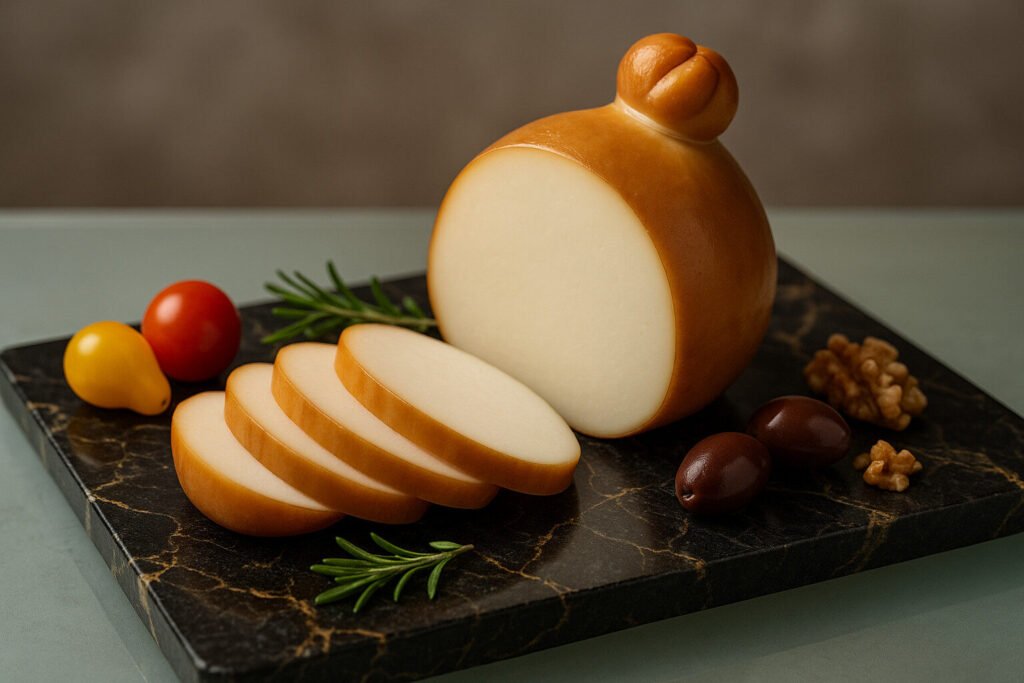Scamorza Cheese
Definition and Scope
Scamorza is a Southern Italian stretched-curd cheese traditionally made from cow’s milk. It belongs to the pasta filata family, sharing production techniques with mozzarella but undergoing additional drying and aging. This cheese is recognized for its distinctive teardrop shape, often achieved by tying the curd with string during formation. Scamorza is commonly sold fresh or lightly smoked, with the smoked variant known as Scamorza Affumicata.
The cheese’s scope extends across various Italian regions, particularly Puglia and Basilicata, where it holds Protected Geographical Indication status. It serves as a versatile table cheese and cooking ingredient, bridging fresh and aged pasta filata categories. Its moisture content and mild flavor profile make it suitable for numerous culinary applications, from simple slicing to melting in cooked dishes.
Production Process
Scamorza production begins with pasteurized cow’s milk heated and inoculated with thermophilic starter cultures. Rennet is added to coagulate the milk, forming a solid curd that is then cut and whey-drained. The curd undergoes hot water stretching and kneading, characteristic of pasta filata cheeses, which creates its fibrous, pliable texture.
After shaping into characteristic pear-like forms, the cheese is brined for several hours to develop flavor and preserve the rind. Some varieties undergo cold smoking over beechwood or other hardwoods, imparting a golden-brown hue and smoky aroma. The final step involves air-drying for one to two weeks, resulting in a semi-soft cheese with approximately 45% moisture content.
Sensory Profile
Fresh Scamorza presents a mild, milky flavor with slight tanginess and buttery notes. Its texture is semi-soft and elastic, becoming stringy when melted. The pale ivory interior has a smooth, shiny surface with minimal eye formation, while the thin rind remains edible and supple.
Smoked Scamorza develops additional characteristics including a distinctive woody aroma and golden-brown colored rind. The smoking process introduces subtle savory notes that complement the inherent dairy sweetness. Both varieties maintain a clean finish without bitterness, though the smoked version carries longer-lasting smoky undertones.
Culinary Applications
Scamorza’s excellent melting properties make it ideal for baked pasta dishes, pizzas, and grilled sandwiches. It develops a creamy, stringy consistency when heated, similar to mozzarella but with slightly more pronounced flavor. The cheese is frequently paired with vegetables, cured meats, and robust sauces in traditional Italian cooking.
Smoked Scamorza adds depth to antipasto platters and enhances the flavor profile of risottos and stuffed meats. Its ability to retain shape while melting makes it suitable for skewers and grilled preparations. Both varieties can be enjoyed fresh at room temperature to appreciate their full flavor spectrum.
Regional Variations
Traditional Scamorza production centers in Southern Italy, particularly Puglia where it benefits from specific environmental conditions. The cheese must meet strict production protocols to receive PGI (Protected Geographical Indication) status, ensuring authenticity. Regional differences emerge in smoking techniques, with some producers using local woods like chestnut or oak.
Modern variations include Scamorza made from buffalo milk, which yields a richer flavor and creamier texture. Some artisan producers create herb-infused or pepper-crusted versions, though these remain less common than the classic varieties. International adaptations sometimes incorporate different milk types or smoking materials, though these fall outside traditional classification.

